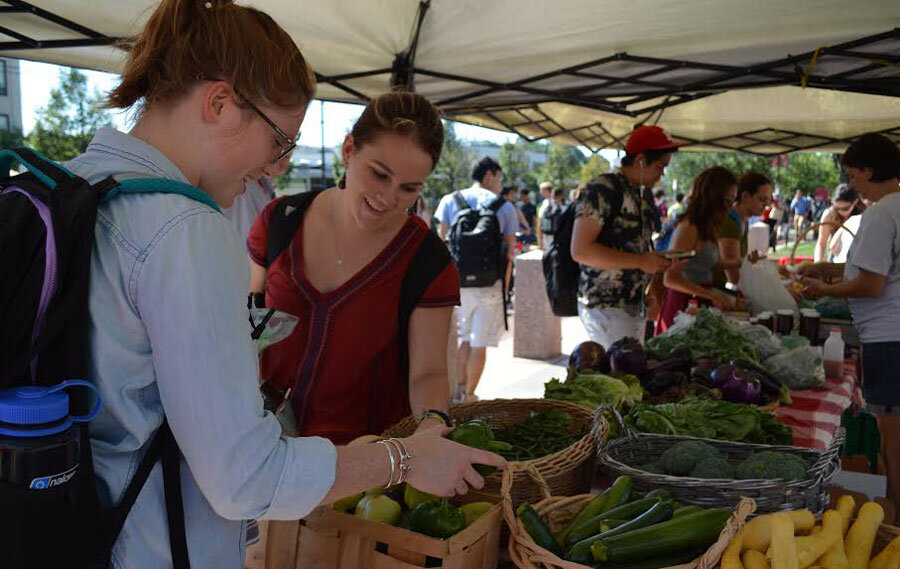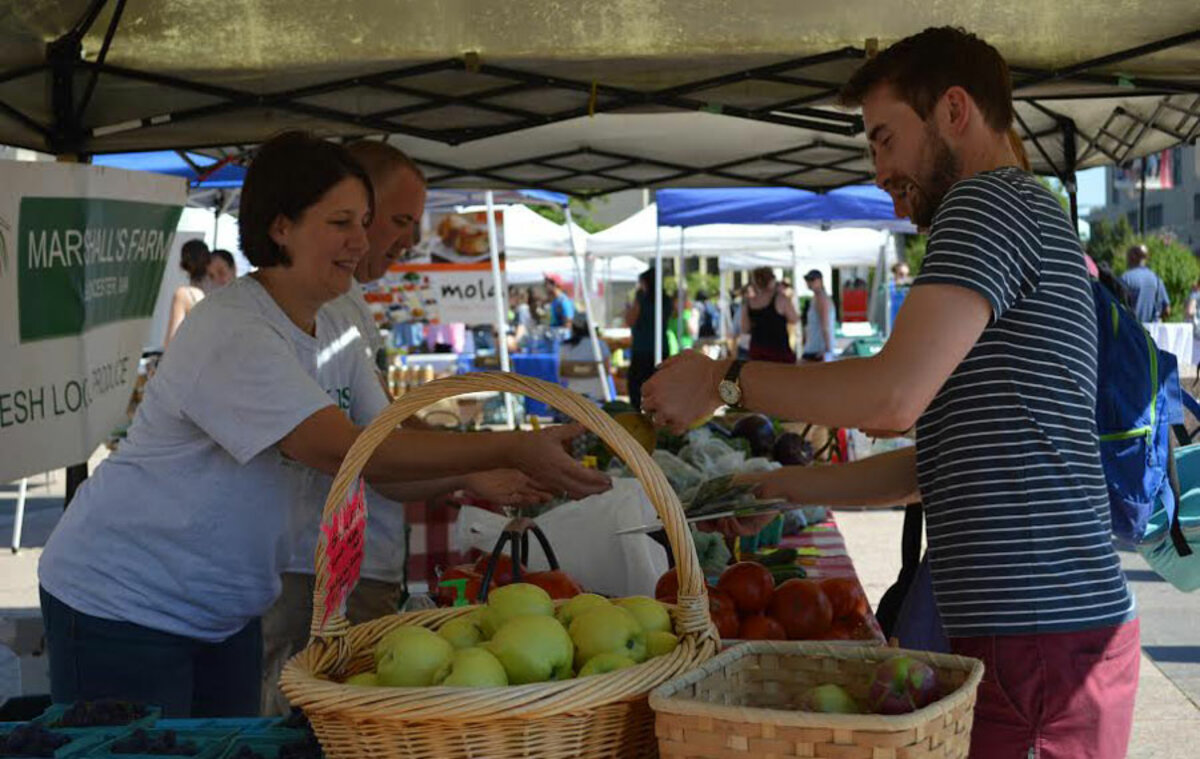How sustainable food movement is shaping college dining – and vice versa
Loading...
When Boston University began its sustainable dining initiative in 2007, it started small: hire someone to coordinate the program. Focus on sorting and reducing kitchen waste. Start a compost scheme.
Today, not only does the university recycle, repurpose, or compost about 75 percent of waste from its kitchens, it also sources 22 percent of its food from sustainable suppliers. All eggs served on campus, for instance – about 4 million a year – are cage-free and independently certified as humane. The 23 tons of ground beef, hamburgers, and hot dogs that make it to the university’s three dining halls are sourced from 100 percent grass-fed Maine cows.
The story is echoed in the dining halls of colleges across the country. Driven by a broader movement toward sustainable practices – as well as a desire to attract students who increasingly place a premium on locally sourced and humanely raised food – higher-education institutions have increasingly committed to buying more local and organic products from vendors who engage in fair, transparent methods of supplying food.
The result is that universities are growing more aware of what works and what doesn’t when it comes to serving fresh, healthy, and environmentally sound meals to students – and of the impact their efforts can have on attitudes and local economies.
“Universities play a tremendous role in letting people know the importance of sustainability,” says Lydia Zepeda, a professor of consumer science and an expert on sustainable consumption at the University of Wisconsin in Madison. Not only do such institutions wield considerable purchasing power within their communities, she says, but they can also leverage a lot of publicity around the issue.
More than 600 US schools now participate in the sustainability tracking program run by the Association for the Advancement of Sustainability in Higher Education (AASHE) – one of a number of organizations that help colleges assess their sustainable practices. Between 2013 and 2014, campuses saw a 60 percent rise in regional and local food initiatives, the group's latest report found.
While the overall impact of these trends has been difficult to measure – different institutions have different ways of measuring success – it's easy to see how big the potential is for local businesses: Food service sales at colleges and universities for 2015 are expected to hit about $16.2 billion, or 2.4 percent of the food industry total, according to research and consulting firm Technomic.
"The buying power is a big deal," says Professor Zepeda.
Working with students, partners
For many institutions, student engagement has been key to getting their sustainability initiatives off the ground. As part of its program, BU puts up signs about the various ingredients that go into each meal, hosts information campaigns, and holds a weekly farmers’ market in an attempt to get students to buy local, organic food.
Such efforts resonated with Lucy Mui, an international relations major. As a freshman at BU, she says she had little concern for where her food came from.
“With the signage and campaigns in our dining halls, I began to consider the stories behind my meals – the people, the inputs, the process,” said Ms. Mui, now a senior and an intern with the university’s sustainability initiative, in an e-mail. “It opened up a whole new dimension of food for me.”
Across the country in northeast Los Angeles, Occidental College is engaged in a similar campaign to explain the ethics of eating, says Dylan Bruce, a senior and head intern for Occidental's sustainability program. Measures include a weekly organic bar and an effort to include locally or sustainably grown ingredients in familiar meals.
“Even if [students] are paying $4 more per plate, they see they are getting a great meal,” he says. “It’s about putting it into perspective for them.”
That understanding is critical to both ensuring the program’s success and extending its impact beyond students’ time at the university, Mr. Bruce says. “It’s not just about leveraging the purchasing impact of the institution, but the buying power of the students.”
At other schools, students’ interest in social justice and environmental issues has been a driving force behind kitchens’ move away from industrial-sized cans and toward local produce. More than 70 percent of food service operators at colleges and universities say they practice social and environmental responsibility to appeal to students, according to a May report by Technomic.
At Bowdoin College in Brunswick, Maine, “students approach us continually with ideas and suggestions,” says Michele Gaillard, the school’s associate director of dining operations. “Many of the general sustainability initiatives we implement have come from the students.” Among the college’s points of pride: its organic garden, instituted by a group of students in 2005.
For some schools, finding the right service partner has also been crucial. Kalamazoo College, a liberal arts institution in southwest Michigan, has worked closely with local food service provider Creative Dining Services to develop relationships with farmers and suppliers in the area since the college’s contract with multinational conglomerate Sodexo ended in 2013.
Creative Dining “has an appetite for local, sustainable efforts,” says Sarah Westfall, the school’s vice president for student development and dean of students. “They are absolutely essential to our process.”
A question of priorities
Along with learning what’s effective when it comes to providing sustainable service, colleges have also learned what isn’t.
The most enduring challenge, they say, has been balancing priorities – in particular the cost of food products against accessibility, quality, and the institution’s own values.
For one thing, available ingredients tend to vary across regions, thus dictating what a college can and can't source locally. Because New England is home to few meat processing plants, for instance, access to local poultry and beef has been a problem, says Bowdoin’s Ms. Gaillard.
“I don’t know that there are enough chickens in the state to last us a week,” she says.
The challenge is amplified for bigger institutions like BU, which is home to more than 30,000 students. While the university has more of an impact on local businesses, its dining staff struggles to find consistent, quality ingredients because it is often forced to source from a variety of suppliers. “Our size can be a challenge when it comes to sourcing from small, sustainable farms,” says Sabrina Pashtan, the university's sustainability coordinator.
Pockets of resistance remain within the student body, as well. “There will always be resisters to change, and I happen to be friends with many of them,” says Mui, the BU student.
Objections can range from cost or individual tastes, but Mui says among her friends, there’s also an objection to being told what to eat.
“It's an uphill battle. It's a process,” says Amy Muñoz, associate vice president for hospitality services at Occidental College, a signatory of the national sustainability campaign Real Food Challenge, which has a separate set of criteria for what constitutes “real food.”
“We still make choices that make sense to us,” Ms. Muñoz says.
Bowdoin and Kalamazoo have developed their own methods for assessing progress, which they continue to refine.
“It’s hard to quantify this,” Gaillard says. “I know there are other schools working on coming up with ways to track how well you are doing. Eventually we will be asked to answer those questions.”
But, she says, “there’s certainly a wonderful feel-good aspect to what we’re doing. One hopes we’re doing good for the environment, for the local economy, for individual farmers.
“Food is such a big deal to us,” she says.







